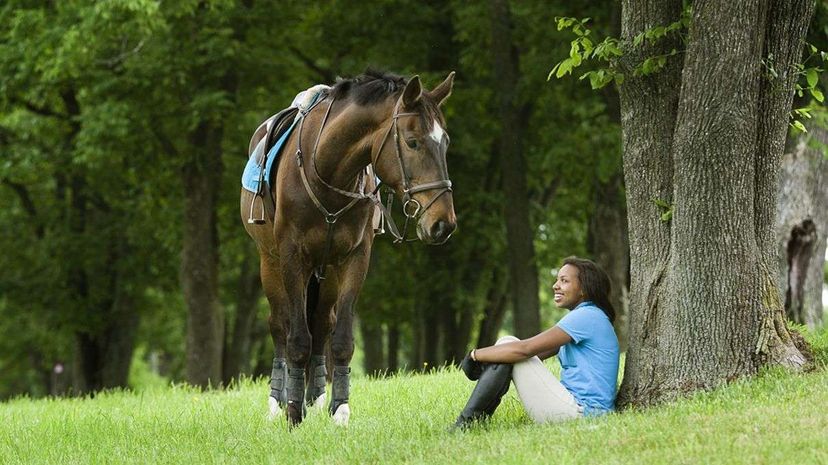
Humans and horses have lived and worked together for thousands of years, and though we've succeeded in teaching these creatures to take direction from us while we ride on their backs, carry us into battle like it's no big deal, and drag farm machinery around behind them, horses have never been considered among the smarter animals. This is due in part to our notion that another animal's intelligence can be demonstrated through how readily they learn to communicate with us about what they want, through the use of vocal or gestural symbols.
But between humans and horses, communication has traditionally been viewed as one-sided: you tell the horse to turn left, the horse turns left. Or runs back to barn with you on its back if it doesn't feel like turning left. And that's not really a conversation.
Advertisement
However, a new study published in the journal Applied Animal Behaviour Science finds that horses actually can be trained to use symbols in order to tell humans what they want — a cognitive step beyond knowing that a nuzzle might get them an apple or carrot.
Signifying Desire
A group of Norwegian researchers trained 23 horses, all accustomed to wearing blankets in the cold, to indicate whether they'd like their blanket put on or removed by training them to point to one of three different symbol boards posted on a fence. The horses were given carrot pieces as a reward for displaying "right" behavior, but unlike most horse training, the behavior the trainers were looking for didn't involve correctly completing human-serving tasks (stop, turn, change gait, come this way).
Instead, the horses received rewards when they told the trainers whether they were feeling hot or cold at the moment by pointing with their noses to one of three icons which essentially meant:
"put the blanket on"
"don't mess with my current blanket situation"
At first, the researchers rewarded the horses with carrots when they demonstrated "correct" behaviors, while "wrong" responses (like touching the "blanket on" symbol when they were already wearing a blanket) were ignored.
"During the training, and especially during the heat and cold challenge tests, the horses were reminded of the effect of blankets on their own thermal comfort." says co-author Dr. Cecilie M. Mejdell, a researcher at the Norwegian Veterinary Institute in Oslo. "When we were certain that the horses knew the differences between the symbols and the actions connected to them, the critical point was the transformation into the free choice situation. At this stage, the change or no change of blanket status might be a reward in itself, although we continued to reward a choice, any choice."
The horses received training for 10-15 minutes a day for no more than 14 days, and all 23 horses mastered the communication method in that time. In fact, on average, members of the herd learned to recognize, understand, and choose between the symbols in just 10 days.
"Of course, the use of symbols by some animals, like apes, is like a language, and is far more impressive," says Mejdell. "But our study adds to the knowledge about cognition in horses. Some horse owners will probably be able to train their horse this way."
Although horses don't outperform some of the handful of other smartypants animals that can learn to communicate with us through symbolic vocabularies and gestures — dolphins, apes and pigeons among them — this study is much less controversial than another animal communication study that came out this month.
Aqualinguistics?
Dolphin researchers in Ukraine recently published a paper in the open-access journal St. Petersburg Polytechnical University Journal: Physics and Mathematics, claiming to have recorded two Black Sea bottlenose dolphins floating side-by-side, conversing with each other by stringing together vocal symbols to form sentences. The dolphins took turns "talking," indicating a conversational back-and-forth.
"It is complete bull, and you can quote me," Richard Connor, a University of Massachusetts-Dartmouth marine biologist, told National Geographic this month.
The reason for his skepticism lies in the fact that the dolphins in question were next to each other with their heads at the surface of their tank during the "conversation" in question, and dolphin vocalizations always point forward like the beam of a flashlight, and are at their best sonic advantage when the animals have a few feet of water above them. This suggests the two dolphins wouldn't have heard each other well.
Dolphin communication is complicated, and both believers and detractors of this new study have decades of research on which to base their opinions. As our understanding of horse cognition and communication grows, who knows — maybe in 30 years we'll have horse researchers insulting each other in public!
Advertisement
